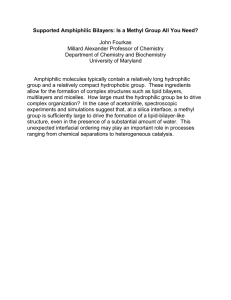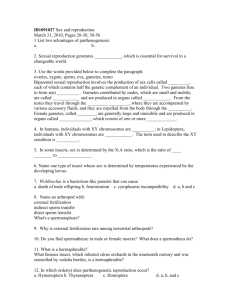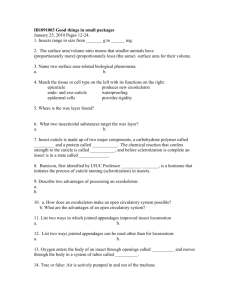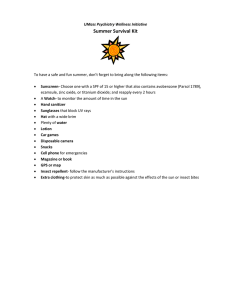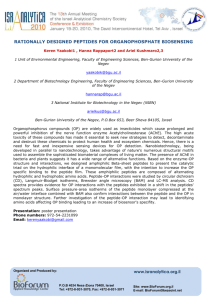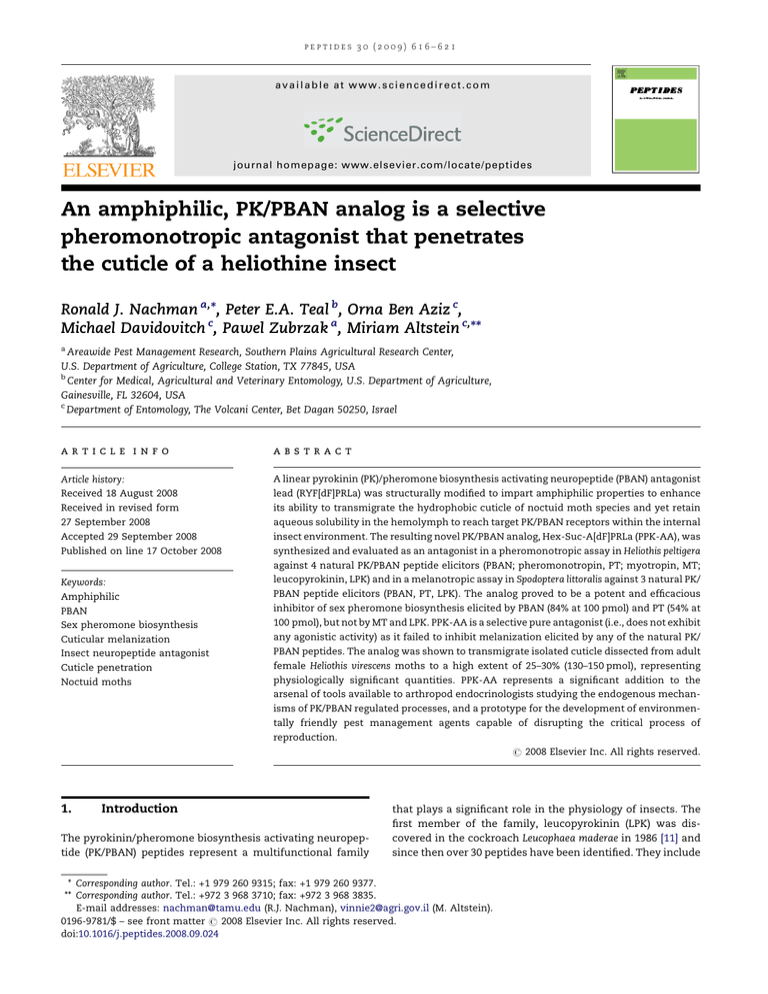
peptides 30 (2009) 616–621
available at www.sciencedirect.com
journal homepage: www.elsevier.com/locate/peptides
An amphiphilic, PK/PBAN analog is a selective
pheromonotropic antagonist that penetrates
the cuticle of a heliothine insect
Ronald J. Nachman a,*, Peter E.A. Teal b, Orna Ben Aziz c,
Michael Davidovitch c, Pawel Zubrzak a, Miriam Altstein c,**
a
Areawide Pest Management Research, Southern Plains Agricultural Research Center,
U.S. Department of Agriculture, College Station, TX 77845, USA
b
Center for Medical, Agricultural and Veterinary Entomology, U.S. Department of Agriculture,
Gainesville, FL 32604, USA
c
Department of Entomology, The Volcani Center, Bet Dagan 50250, Israel
article info
abstract
Article history:
A linear pyrokinin (PK)/pheromone biosynthesis activating neuropeptide (PBAN) antagonist
Received 18 August 2008
lead (RYF[dF]PRLa) was structurally modified to impart amphiphilic properties to enhance
Received in revised form
its ability to transmigrate the hydrophobic cuticle of noctuid moth species and yet retain
27 September 2008
aqueous solubility in the hemolymph to reach target PK/PBAN receptors within the internal
Accepted 29 September 2008
insect environment. The resulting novel PK/PBAN analog, Hex-Suc-A[dF]PRLa (PPK-AA), was
Published on line 17 October 2008
synthesized and evaluated as an antagonist in a pheromonotropic assay in Heliothis peltigera
against 4 natural PK/PBAN peptide elicitors (PBAN; pheromonotropin, PT; myotropin, MT;
Keywords:
leucopyrokinin, LPK) and in a melanotropic assay in Spodoptera littoralis against 3 natural PK/
Amphiphilic
PBAN peptide elicitors (PBAN, PT, LPK). The analog proved to be a potent and efficacious
PBAN
inhibitor of sex pheromone biosynthesis elicited by PBAN (84% at 100 pmol) and PT (54% at
Sex pheromone biosynthesis
100 pmol), but not by MT and LPK. PPK-AA is a selective pure antagonist (i.e., does not exhibit
Cuticular melanization
any agonistic activity) as it failed to inhibit melanization elicited by any of the natural PK/
Insect neuropeptide antagonist
PBAN peptides. The analog was shown to transmigrate isolated cuticle dissected from adult
Cuticle penetration
female Heliothis virescens moths to a high extent of 25–30% (130–150 pmol), representing
Noctuid moths
physiologically significant quantities. PPK-AA represents a significant addition to the
arsenal of tools available to arthropod endocrinologists studying the endogenous mechanisms of PK/PBAN regulated processes, and a prototype for the development of environmentally friendly pest management agents capable of disrupting the critical process of
reproduction.
# 2008 Elsevier Inc. All rights reserved.
1.
Introduction
The pyrokinin/pheromone biosynthesis activating neuropeptide (PK/PBAN) peptides represent a multifunctional family
that plays a significant role in the physiology of insects. The
first member of the family, leucopyrokinin (LPK) was discovered in the cockroach Leucophaea maderae in 1986 [11] and
since then over 30 peptides have been identified. They include
* Corresponding author. Tel.: +1 979 260 9315; fax: +1 979 260 9377.
** Corresponding author. Tel.: +972 3 968 3710; fax: +972 3 968 3835.
E-mail addresses: nachman@tamu.edu (R.J. Nachman), vinnie2@agri.gov.il (M. Altstein).
0196-9781/$ – see front matter # 2008 Elsevier Inc. All rights reserved.
doi:10.1016/j.peptides.2008.09.024
peptides 30 (2009) 616–621
PKs, myotropins (MTs), PBAN, melanization and reddish
coloration hormone (MRCH), diapause hormone (DH), pheromonotropin (PT), and peptides derived from the PBAN gene or
cDNA of various moths (termed pheromonotropic b and g
peptides), all of which share the common C-terminal
pentapeptide FXPRL-amide (X = S, T, G or V) [4,25,26]. Functions of the PK/PBAN family include stimulation of sex
pheromone biosynthesis in moths [4,14,25–27], and mediation
of key functions associated with feeding (gut muscle contractions) [15,29], development (embryonic diapause, pupal
diapause and pupariation) [12,16,18,19,33,34] and defense
(melanin biosynthesis) [6,13] in a variety of insects (moths,
cockroaches, locusts and flies). Studies have shown that all of
the above functions can be stimulated by more than one
peptide, and that the peptides do not exhibit species specificity
[1,10,25,26]. The functional diversity of the PK/PBAN family
raises many questions regarding the mechanisms by which
these neuropeptides elicit their effects. Antagonists, particularly selective ones, can shed light on this issue.
As potent and specific as these PK/PBAN molecular messengers are, these neuropeptides in and of themselves are not
suitable either as pest insect control agents or tools for insect
neuroendocrinologists. Direct use of neuropeptides for insect
control is impractical because the insect cuticle contains an
apolar lipid matrix that, for the most part, inhibits penetration
of polar compounds like peptides and because they are rapidly
degraded by peptidases in the hemolymph and tissues within
insects [17,21]. Therefore, the development of agonists and
antagonists with enhanced cuticle/gut penetrability can overcome at least one of these limitations and represents a key step
in the development of control techniques employing analogs of
insect neuropeptides capable of disrupting critical life processes
regulated by the PK/PBAN class.
These problems have been previously addressed with PK/
PBAN agonists through the development of pseudopeptide
analogs with amphiphilic character, which confers an ability
to penetrate the hydrophobic insect cuticle and simultaneously maintains the water solubility necessary for them to
re-emerge in the insect circulatory system and reach their
target receptor sites [2,20,21,23,30,32]. Experiments involving
topical application of aqueous solutions (without addition of
an organic solvent component) of members of the PK/PBAN
family did not transmigrate the isolated cuticle of the tobacco
budworm moth Heliothis virescens in statistically significant
quantities [2,23,32]. Structural modification to produce PK
analogs that feature amphiphilic properties greatly enhances
their ability to both penetrate the hydrophobic cuticle, and
maintains the aqueous solubility required to reach their
target receptor once they encounter the hemolymph [2,23].
The development of a series of pseudopeptide analogs of this
neuropeptide family began with the addition of various
hydrophobic groups to the N-terminus of the C-terminal
pentapeptide active core, which in conjunction with the
polar/charged Arg side chain, confer an amphiphilic property.
Hydrophobic groups appended to the N-terminus included
fatty acids of various chain lengths, aromatic acids, as well as
hydrophobic amines attached via a succinnic acid linker
[17,21–23,30,31]. Many of these amphiphilic analogs showed
greater in vivo potency in a pheromonotropic assay than the
native 33-membered PBAN when delivered via injection into
617
female H. virescens moths. When applied to dissected pieces of
H. virescens cuticle, 24 h recoveries of a series of amphiphilic
pyrokinin analogs ranged from 5 to 70%, dependant on the
hydrophobic nature of the individual analog. In addition,
prolonged pheromone production exceeding 20 h following a
single topical application of an amphiphilic pyrokinin analog
to H. virescens moths was observed. The nature of the
hydrophobic moiety could also influence the duration of
the slow release of a given amphiphilic pyrokinin analog. The
results demonstrated that the insect cuticle could serve as a
reservoir for the time-release of a physiologically active,
amphiphilic analog of an insect neuropeptide [22].
In a previous study we demonstrated that replacement of the
amino acid Ser in a sequence derived from the C-terminus of
PBAN (YFSPRLa, which contains the signature sequence of the
PK/PBAN family) with dF and addition of an amino acid Arg at
the N-terminus resulted in the disclosure of a potent antagonist
which was able to inhibit PBAN evoked pheromone biosynthesis in Heliothis peltigera [35]. The peptide (RYF[dF]PRLa) was a
selective, pure (i.e., did not exhibit any agonistic activity)
pheromonotropic inhibitor and did not inhibit melanin formation in Spodoptera littoralis [8]. The modification of the PBAN
antagonist analog to enable penetration of the cuticle of an
insect would be a logical extension of the previous studies on
this lead antagonist [35] and those focused on the development
of amphiphilic PK/PBAN agonists [22]. In this manuscript, we
describe the synthesis of an amphiphilic version of this dF PK/
PBAN antagonist that features an aliphatic amine appended to
the N-terminus via a di-acidic linker (succinnic acid). This
analog, Hex-Suc-A[dF]PRLa, is labeled PPK-AA (PBAN PyrokininAmphiphilic Antagonist) and was evaluated for both agonist
and antagonist activity in a pheromonotropic assay in adult
female H. peltigera and a melanotropic assay in larvae of S.
littoralis. Following this, it was evaluated for its ability to
penetrate dissected pieces of the cuticle of another heliothine,
H. virescens.
2.
Materials and methods
2.1.
Insects
S. littoralis larvae were kept in groups of 100–200 in plastic
containers (40 cm 30 cm 20 cm). Sawdust was placed at
the bottom of the container and the top was covered with
cheesecloth. Larvae were fed on castor bean leaves and kept in
a thermostatically regulated room at 25 2 8C with a light:dark regime of 14:10 h and 60% relative humidity.
H. peltigera moths were reared on an artificial diet as
described previously [9]. Pupae were sexed and females and
males were placed in separate rooms with a dark/light regime
of 10:14 h, at 25 2 8C and 60–70% relative humidity. Adult
moths were kept in screen cages and supplied with a 10% sugar
solution. Moth populations were refreshed every year with
males caught from the wild by means of pheromone traps, as
described previously [9]. All females used in this study were 3.5
days old.
H. virescens moths were obtained as pupae from North
Carolina State University. Pupae were sexed and males discarded. Females were held in 30 cm3 plastic cages equipped
618
peptides 30 (2009) 616–621
with mesh sleeves to allow for removal of adults. Newly
enclosed adults were placed in new cages daily held in
environmental chambers at 25 2 8C, 65% relative humidity
with a 14:10 h light:dark photoperiod and provided with a 5%
sucrose solution as food.
2.2.
Peptide and pseudopeptide analog synthesis and
purification
2.2.1.
Synthesis of PBAN 1-33NH2, PT, LPK and MT
Hez-PBAN [28] and Pseudaletia (Mythimna) separata Pss-PT [14]
were synthesized on an ABI 433A automatic peptide synthesizer on Rink amide 4-methylbenzhydrylamine (MBHA) resin
by means of the FastMocTM chemistry as described previously
[11,35]. Synthesis of Leucophaea maderae LPK (Lem-LPK) [11] and
Locusta migratoria (Lom-MT-II) [29] was carried out via 9fluorenylmethoxycarbonyl (Fmoc) methodology on Rink
Amide resin (Novabiochem, San Diego, CA) using Fmoc
protected amino acids (Advanced Chemtech, Louisville, KY)
on an ABI 433A peptide synthesizer (Applied Biosystems,
Foster City, CA) as described previously [17]. The purity of all
peptides was assessed by analytical reverse-phase highperformance liquid chromatography (RP-HPLC) [3,34] and
was found to be in the range of 90–95%. Purified peptides
were characterized by time-of-flight mass spectrometry (TOFMS) and amino acid analysis of hydrolyzates.
2.2.2. Amphiphilic pseudopeptide analog synthesis and
purification
Hexylamine (Hex) and succinic acid (Suc) were purchased from
Aldrich Chemical (Milwaukee, WI). Synthesis of amphiphilic
analog PPK-AA (Hex-Suc-A[dF]PRLa) was accomplished in a
stepwise manner. A[dF]PR(PMC)L-Rink Amide resin complex
was synthesized via Fmoc methodology on Rink Amide resin
(Novabiochem, San Diego, CA) using Fmoc protected amino
acids (Applied Biosystems, Foster City, CA) on an ABI 433A
peptide synthesizer (Applied Biosystems, Foster City, CA) under
previously described conditions [23]. The pseudopeptide analog
was synthesized by condensation of succinic acid and
hexylamine to the Rink Amide peptide complex above by
stirring with 1 equiv. of 1,3-diisopropylcarbodiimide/i-hydroxy2azabenzotriazole in dimethyl sulfoxide for 4 h at room
temperature for each step. The crude pseudopeptide was
cleaved from the resin and protecting groups removed by
treatment with a mixture of trifluoroacetic acid (TFA) (90%),
anisole (5%), thioanisole (4%) and 1,2-ethanedithiol (1%) for 1 h.
The resin was removed via filtration and volatile reagents were
removed with a Savant Speed Vac concentrator. Crude products
were purified on a Waters C18 Sep Pak cartridge and a Delta Pak
C18 reverse-phase column (8 mm 100 mm, 15 mm particle size
and 100A pore size) on a Waters 600 HPLC controlled with a
Millennium 2010 chromatography manager system (Waters,
Milford, MA) with detection at 214 nm at ambient temperature.
Solvent A = 0.1% aqueous trifluoroacetic acid (TFA) and Solvent
B = 80% aqueous acetonitrile containing 0.1% TFA. Conditions:
initial solvent consisting of 10% B was followed by the waters
linear program to 90% B over 25 min; flow rate, 2 ml/min.
Retention time on C18 column: 12.0 min. Retention time on
Protein Pak 125 column: 6.0 min. The pure peptides were
analyzed and quantified via amino acid analysis. Each peptide
sample was purged with N2 and the peptide hydrolyzed with
vapor phase HCl for 24 h at 105 8C. Precolumn derivatization and
HPLC analysis was accomplished by the standard Pico Tag
method supplied by Waters (Milford, MA). The observed amino
acid ratios were as expected for PPK-AA: A[1.0], F[1.0], L[1.0],
P[0.9], R[1.1]. Mass spectra were obtained on a Kratos Kompact
Probe MALDI-TOF machine (Kratos Analytical, Ltd., Manchester, UK) using a-cyano-4-hydroxycinnamic acid as a matrix,
recording the presence of the following molecular ions for PPKAA: 785.5 [calc MH+ = 784.0].
2.3.
Pheromonotropic bioassay
The pheromonotropic bioassay was performed with H.
peltigera as described previously [5]. Stimulatory activity of
the PK/PBAN peptides or PPK-AA (at 1 nmol) was determined
by monitoring their ability to induce sex pheromone biosynthesis. Females injected with 1 pmol PBAN1-33NH2 served as a
reference for stimulatory activity. Antagonistic activity was
determined by monitoring the ability of the amphiphilic, DPhe linear analog PPK-AA to inhibit sex pheromone biosynthesis that was elicited by an injected exogenous stimulator
(PBAN1-33NH2, PT, MT or LPK at 1, 1, 10 and 30 pmol,
respectively, see results). Females injected with the elicitors
at the indicated concentrations served as a reference for
maximal stimulation and those injected with 100 mM phosphate buffer served to determine the basal pheromone
biosynthesis during the photophase. The pheromone content
in buffer-injected moths did not exceed 10 ng/female. The
pheromone glands were excised 2 h post-injection and sex
pheromone was extracted and quantified by capillary gas
chromatography as described previously [5]. The experiment
was performed with a minimum of 8 females per treatment.
2.4.
Melanotropic bioassay
The melanotropic bioassay was performed as described
previously [8]. The melanotropic stimulatory activity of the
PK/PBAN peptides or PPK-AA was determined by evaluating
their ability to induce cuticular melanization in larvae. Larvae
injected with 5 pmol PBAN1-33NH2 served as a reference for
stimulatory activity. Antagonistic activity was determined by
monitoring the ability of the amphiphilic, D-Phe linear analog
(at 1 nmol), injected together with the elicitors PBAN1-33NH2,
PT or LPK (at 5, 5 and 15 pmol, respectively, see results), to
inhibit cuticular melanization. Larvae injected with the
elicitors at the indicated concentrations served as a reference
for maximal stimulation, and those injected with 50 mM
HEPES, pH 7.6 served to determine the basal cuticular
melanization of the ligated insects. Each experiment involved
analysis of the intensity of the melanized area in untreated
and ligated larvae, and in larvae that were ligated and injected
with buffer, PBAN or the tested amphiphilic analog. The
cuticular melanization was quantified as the ratio between the
optical density and the scanned cuticular area (in millimeters)
and was compared between control and experimental
animals. All experiments were performed with a minimum
of 9 or 10 larvae per treatment. The only experiments taken
into account were those in which the extent of melanization in
buffer-injected larvae did not differ significantly from that of
peptides 30 (2009) 616–621
ligated animals, and did differ significantly from that of those
injected with PBAN1-33NH2 (at 5 pmol).
2.5.
Isolated cuticle penetration assay
Cuticle penetration assays were conducted using tissue
obtained from the abdomen of female moths. Pieces of cuticle,
ca. 0.4 cm2, were prepared as described elsewhere [32] and
floated cell-side down in wells of ELISA plates (Corning, 96well Easy Wash) that had been previously blocked by filling
with 1% gelatin in 10 mM sodium phosphate buffer containing
150 mM NaCl (pH 7.25) (PBS) [32]. Analog PPK-AA (0.5 nmol)
was applied to the center of the cuticle pieces in a 0.5 ml drop of
H2O using micromanipulator and observed for 5 min to insure
that the drops did not slide off. Lids were applied to the plates
and the plates were placed on an orbital shaker operated at
80 rpm. Cuticle was removed from wells at 1, 2, 4, 6, 8, 20 and
24 h after application of the analog. After incubation, 100 pmol
of internal standard ( pGlu-Arg-Phe-NH2) were added and the
contents of the wells were prepared for chemical analysis. Six
replicates were made for each data point.
Samples were analyzed by mass spectroscopy (MS) using a
Thermo Finnigan LCQ DECA Max MS with electrospray
ionization (positive ion). The MS was interfaced to a Thermo
Finnigan liquid chromatography system consisting of a P4000
quaternary gradient pump, an AS 3000 autoinjector and a
UV6000 diode array detector. Reversed phase liquid chromatographic separation (RPLC) was performed by injecting 20 ml
of sample onto a Zorbax RX-C18 column (4.6 mm 250 mm,
5 mm, Agilent Technologies) operated at 60 8C using the
following solvents: A = methanol with 1.0% formic acid;
B = water with 10 mM ammonium formate; C = 90% acetonitrile/10% H2O with 10 mM ammonium formate. Conditions of
chromatography were 4:90:6 (A:B:C) 1 min followed by a
gradient to 4:58:38 (A:B:C) over 8 min followed by a second
gradient to 4:0:96 (A:B:C) over 6 min and held at this for 2 min.
Quantitation was accomplished by comparing the areas of
base ions for PPK-AA (M/Z 785.23-786.23) and pGlu-Arg-PheNH2 (M/Z 487–488) after calculating the ratio of intensities of
these ions during analysis of equimolar amounts of the
compounds analyzed without application to the cuticle.
2.6.
619
evaluated for any residual agonist activity. This analog did not
elicit any detectable level of sex pheromone production at
1 nmol (the activity obtained was 1% of that of 1 pmol of
PBAN).
The linear D-Phe amphiphilic analog PPK-AA was tested for
its antagonistic activity against different elicitors at 100 pmol
and 1 nmol. As can be seen in Fig. 1, PPK-AA inhibited PBAN
mediated activity, decreasing sex pheromone biosynthesis by
84 and 69% at 100 pmol and 1 nmol, respectively. PPK-AA also
inhibited the elicitor PT by about 54% at 100 pmol, but proved
less effective against MT, where the observed inhibition was
not statistically significant from that obtained in the absence
of PPK-AA. PPK-AA was completely ineffective in inhibiting
LPK as a pheromonotropic elicitor. The combined agonistic
and antagonistic examination of PPK-AA clearly reveals that it
is a pure pheromonotropic antagonist, although it demonstrates a distinct pattern of selectivity with the natural
elicitors, inhibiting two (PBAN, PT) out of four (PBAN, MT,
PT, LPK).
3.2.
Melanotropic bioassay
The amphiphilic analog PPK-AA was also evaluated for
melanotropic agonistic activity at 100 pmol. The analog PPKAA demonstrated very low or negligible stimulatory activity
that was not statistically significant from buffer injected
larvae (the activity obtained was 5% compared with that of
5 pmol PBAN).
The linear D-Phe amphiphilic analog PPK-AA was tested for
antagonistic activity at 1 nmol with PBAN1-33NH2, PT and LPK
as stimulators. Inhibition activity less than 40% and was not
considered as positive in this assay [8]. PPK-AA failed to meet
the criteria as an inhibitor for any of the elicitors.
3.3.
Isolated cuticle penetration assay
Following application of 500 pmol of the amphiphilic analog
PPK-AA to the surface of isolated cuticle dissected from the
abdomen of adult female H. virescens moths, the quantity
transmigrating through was monitored at various time inter-
Statistical analysis
The results of the pheromonotropic and melanotropic assays
were subjected to one-way ANOVA. The significance of
differences among means was evaluated with the Tukey–
Kramer HSD (honestly significant difference) test at P < 0.05.
Data from the cuticle penetration assay were analyzed using a
one-way ANOVA and Fishers Least Significant Difference test
using NCSS7 Statistical software and by regression analysis
using GraphPad Prism1 software.
3.
Results
3.1.
Pheromonotropic bioassay
As the focus of this study is on development of an amphiphilic antagonist analog, the PPK-AA (Hex-Suc-A[dF]PRLa) was
Fig. 1 – In vivo inhibition of sex pheromone biosynthesis
elicited by PBAN, PT, MT and LPK by 100 pmol (open bars)
and 1 nmol (dark bars) of the amphiphilic analog PPK-AA
in adult female Heliothis peltigera. The data represent
means W S.E.M. (n = 8–10). An asterisk (*) indicates an
activity that differs significantly (at P < 0.05) from that
obtained by the elicitor itself.
620
peptides 30 (2009) 616–621
Fig. 2 – Penetration of the amphiphilic antagonist analog
PPK-AA through the isolated cuticle dissected from the
abdominal region of adult female Heliothis virescens at 1, 4,
6, 8, 16, 20, and 24 h intervals, as monitored via HPLC. The
data represent means W S.E.M. (n = 6).
vals via LC–MS measurements of the aqueous solution in the
well. The results (Fig. 2) demonstrate that 130–150 pmol
transmigrate the cuticular surface between 8 and 24 h;
representing a high penetration rate of 25–30% of the applied
sample. Previous experiments have demonstrated that neither
PBAN nor its C-terminal pentapeptide, which do not feature
amphiphilic properties, could transmigrate the isolated cuticle
preparation of H. virescens [32].
Testing on isolated cuticle dissected from the abdominal
region of adult females of another heliothine moth, H.
virescens, demonstrates that from an initial topical application
of 500 pmol, a high percentage (25–30%, corresponding to130–
150 pmol) transmigrates from the outer cuticular surface to
the hemolymph side (Fig. 2). This experimental data indicates
that the quantity that penetrates the abdominal heliothine
cuticle is sufficient to reach and exceed the injected dose that
led to 84% inhibition of sex pheromone biosynthesis in the in
vivo pheromonotropic assay.
The results indicate that a peptide antagonist analog can be
modified to impart amphiphilic character, and therefore an
enhanced ability to transmigrate the cuticle of an adult female
moth in physiologically significant quantities, without losing
its intrinsic biological activity. The amphiphilic analog PPK-AA
is a selective antagonist for the pheromonotropic response of
the native hormone, and is therefore a significant addition to
the neuroendocrinologist’s arsenal of tools (in addition to the
already existing linear and backbone cyclic (BBC) antagonists
of the PK/PBAN family of peptides [3,7,35], and topically/orally
active, biostable PK/PBAN agonists [2,20–24]) to study the
endogenous mechanisms of this important aspect of reproduction in heliothine insects. The analog PPK-AA may serve as
a prototype for the development of a novel group of highly
effective, insect-specific and environmentally friendly pest
management agents capable of disruption of the critical
process of reproduction.
Acknowledgements
4.
Discussion
The linear dF PK/PBAN antagonist RYF[dF]PRLa [35] was
modified to impart amphiphilic properties that would
enhance penetration through the hydrophobic cuticle of pest
heliothine insects and yet retain aqueous solubility in the
hemolymph required to reach target PK/PBAN receptors
within the internal environment of the insect. The modification was carried out by first appending a hydrophobic amine
(hexylamine) via a di-acid linker (succinic acid) to the Nterminus of the C-terminal pentapeptide of the parent
antagonist as had been previously achieved with a C-terminal
pyrokinin pentapeptide agonist [22,31]. In the resulting analog
Hex-Suc-A[dF]PRLa (PPK-AA), the F was replaced with an A in
an effort to eliminate any residual agonist response and
therefore maximize the antagonist profile. Amphiphilic
analog PPK-AA demonstrated neither a detectable agonist
response in the pheromonotropic assay of H. peltigera nor a
statistically significant agonist response in the melanotropic
assay in S. littoralis. In the pheromonotropic assay, PPK-AA
demonstrated a selective ability to inhibit the elicitors PBAN
and PT, but not the other PK elicitors MT or LPK (Fig. 1). PPK-AA
proved to be a potent antagonist of the native pheromonotropin PBAN, inhibiting sex pheromone production by 84% at
100 pmol. In the melanotropic assay, PPK-AA at a dose of
1 nmol failed to meet the criteria of an inhibitor of any of the
three PK/PBAN elicitors PBAN, PT or LPK. Therefore PPK-AA
exhibited pure antagonism and was selective for the putative
pheromonotropic receptor.
This research was supported by the US-Israel Binational
Agricultural Research and Development Fund (BARD) (IS-335602) (MA, RJN).
references
[1] Abernathy RL, Nachman RJ, Teal PEA, Yamashita O,
Tumlinson JH. Pheromonotropic activity of naturallyoccurring pyrokinin insect neuropeptides (FXPRLamide) in
Helicoverpa zea. Peptides 1995;16:215–9.
[2] Abernathy RL, Teal PEA, Meredith JA, Nachman RJ.
Induction of moth sex pheromone production by topical
application of an amphiphilic pseudopeptide mimic of
pheromonotropic neruoepeptides. Proc Natl Acad Sci USA
1996;93:2621–5.
[3] Altstein M, Ben-Aziz O, Daniel S, Schefler I, Zeltser I, Gilon
C. Backbone cyclic peptide antagonists, derived from the
insect pheromone biosynthesis activating neuropeptide
(PBAN), inhibit sex pheromone biosynthesis in moths. J Biol
Chem 1999;274:17573–9.
[4] Altstein M. Role of neuropeptides in sex pheromone
production in moths. Peptides 2004;25:1491–501.
[5] Altstein M, Dunkelblum E, Gabay T, Ben Aziz O,
Schafler I, Gazit Y. PBAN-Induced sex-pheromone
biosynthesis in Heliothis-Peltigera: Structure, dose, and
time-dependent analysis. Arch Insect Biochem Physiol
1995;30:307–19.
[6] Altstein M, Gazit Y, Ben Aziz O, Gabay T, Marcus R, Vogel Z,
et al. Induction of cuticular melanization in Spodoptera
littoralis larvae by PBAN/MRCH: Development of
peptides 30 (2009) 616–621
[7]
[8]
[9]
[10]
[11]
[12]
[13]
[14]
[15]
[16]
[17]
[18]
[19]
[20]
a quantitative bioassay and structure function analysis.
Arch Insect Biochem Physiol 1996;31:355–70.
Altstein M, Hariton A. Rational design of insect control
agents: the PK/PBAN family as a study case. In: Biorational
control of arthropod pests: application and resistance
management. New York: Springer; 2008, in press.
Ben-Aziz O, Zeltser I, Altstein M. PBAN selective
antagonists: inhibition of PBAN induced cuticular
melanization and sex pheromone biosynthesis in moths. J
Insect Physiol 2005;51:305–14.
Dunkelblum E, Kehat M. Female sex-pheromone
components of Heliothis peltigera (Lepidoptera: Noctuidae)
chemical-identification from gland extracts and maleresponse. J Chem Ecol 1989;15:2233–45.
Gade G, Hoffmann KH, Spring JH. Hormonal regulation in
insects: facts, gaps, and future directions. Physiol Rev
1997;77:963–1032.
Holman GM, Cook BJ, Nachman RJ. Primary structure and
synthesis of a blocked myotropic neuropeptide isolated
from the cockroach, Leucophaea-Maderae. Comp Biochem
Physiol C Pharmacol Toxicol Endocrinol 1986;85:219–24.
Imai K, Konno T, Nakazawa Y, Komiya T, Isobe M, Koga K,
et al. Isolation and structure of diapause hormone of the
silkworm, Bombyx mori. In: Proceedings of the Japan
Academy Series B-Physical and Biological Sciences, vol. 67;
1991. p. 98–101.
Matsumoto S. Functional diversity of a neurohormone
produced by the subesophageal ganglio: Molecular identity
of melanization and reddish coloration hormone and
pheromone biosynthesis activating neuropeptide 1990.
Matsumoto S, Fonagy A, Kurihara M, Uchiumi K, Nagamine
T, Chijimatsu M, et al. Isolation and primary structure of a
novel pheromonotropic neuropeptide structurally related
to leucopyrokinin from the armyworm larvae, Pseudaletia
separata. Biochem Biophys Res Commun 1992;182:534–9.
Nachman RJ, Holman GM, Cook BJ. Active fragments and
analogs of the insect neuropeptide leucopyrokinin:
structure–function studies. Biochem Biophys Res Commun
1986;137:936–42.
Nachman RJ, Holman GM, Schoofs L, Yamashita O.
Silkworm diapause induction activity of myotropic
pyrokinin (Fxprlamide) insect neuropeptides. Peptides
1993;14:1043–8.
Nachman RJ, Strey A, Isaac E, Pryor N, Lopez JD, Deng JG,
et al. Enhanced in vivo activity of peptidase-resistant
analogs of the insect kinin neuropeptide family. Peptides
2002;23:735–45.
Nachman RJ, Strey A, Zubrzak P, Zdarek J. A comparison of
the pupariation acceleration activity of pyrokinin-like
peptides native to the flesh fly: Which peptide represents
the primary pupariation factor? Peptides 2006;27:527–33.
Nachman RJ, Zdarek J, Holman GM, Hayes TK. Pupariation
acceleration in fleshfly (Sarcophaga bullata) larvae by the
pyrokinin/PBAN neuropeptide family—structure–activity
relationships. Ann NY Acad Sci 1997;814:73–9.
Nachman RJ, Radel PA, Abernathy RL, Teal PEA, Holman
GM. Mimetic analog development of the insect pyrokinin/
PBAN/diapause induction (FXPRLamide) neuropeptide
family. In: Suzuki A, Kataoka H, Matsumoto S, editors.
Molecular mechanisms of insect metamorphosis and
diapause. Tokyo: Industrial Publishing and Consulting, Inc.;
1995. p. 97–106.
621
[21] Nachman RJ, Teal PEA, Ujvary I. Comparative topical
pheromonotropic activity of insect pyrokinin/PBAN
amphiphilic analogs incorporating different fatty and/or
cholic acid components. Peptides 2001;22:279–85.
[22] Nachman RJ, Teal PEA. Amphiphilic mimics of pyrokinin/
PBAN neuropeptides that induce prolonged
pheromonotopic activity following topical application to a
moth. In: Konopinska D, Goldsworthy G, Nachman RJ,
Nawrot J, Orchard I, Rosinski G, editors. Insects: chemical,
physiological and environmental aspects 1997. Wroclaw:
Wroclaw University Press; 1998. p. 145–57.
[23] Nachman RJ, Teal PEA, Radel P, Holman GM, Abernathy RL.
Potent pheromonotropic/myotropic activity of a carboranyl
pseudotetrapeptide analog of the insect pyrokinin/PBAN
neuropeptide family administered via injection and topical
application. Peptides 1996;17:747–52.
[24] Nachman RJ, Teal PEA, Strey A. Enhanced oral availability/
pheromonotropic activity of peptidase-resistant topical
amphiphilic analogs of pyrokinin/PBAN insect
neuropeptides. Peptides 2002;23:2035–43.
[25] Predel R, Nachman RJ. The FXPRLamide (Pyrokinin/PBAN)
Peptide Family, pp. 207–213. In: Kastin, A. editor. Handbook
of biologically active peptides. Amsterdam, The
Netherlands: Elsevier; 1956, pp. 2006.
[26] Rafaeli A, Jurenka R. PBAN regulation of pheromone
biosynthesis in female moths. In: Insect pheromone
biochemistry and molecular biology. NY: Academic Press;
2003. pp. 107–136.
[27] Raina AK, Klun JA. Brain factor control of sex-pheromone
production in the female corn-earworm moth. Science
1984;225:531–3.
[28] Raina AK, Jaffe H, Kempe TG, Keim P, Blacher RW, Fales
HM, et al. Identification of a neuropeptide hormone that
regulates sex-pheromone production in female moths.
Science 1989;244:796–8.
[29] Schoofs L, Holman GM, Hayes TK, Nachman RJ, Deloof A.
Isolation, primary structure, and synthesis of
locustapyrokinin—a myotropic peptide of LocustaMigratoria. Gen Comp Endocrinol 1991;81:97–104.
[30] Teal PEA, Nachman RJ. Prolonged pheromonotropic activity
of pseudopeptide mimics of insect pyrokinin
neuropeptides after topical application or injection into a
moth. Reg Pept 1997;72:161–7.
[31] Teal PEA, Nachman RJ. A brominated-fluorene insect
neuropeptide analog exhibits pyrokinin/PBAN-specific
toxicity for adult females of the tobacco budworm moth.
Peptides 2002;23:801–6.
[32] Teal PEA, Meredith JA, Nachman RJ. Comparison of rates of
penetration through insect cuticle of amphiphilic analogs
of insect pyrokinin neuropeptides. Peptides 1999;20:63–70.
[33] Xu WH, Denlinger DL. Molecular characterization of
prothoracicotropic hormone and diapause hormone in
Heliothis virescens during diapause, and a new role for
diapause hormone. Insect Mol Biol 2003;12:509–16.
[34] Zd’arek J, Myska P, Zemek R, Nachman RJ. Mode of action of
an insect neuropeptide leucopyrokinin (LPK) on
pupariation in fleshfly (Sarcophaga bullata) larvae (Diptera:
Sarcophagidae). J Insect Physiol 2002;48:951–9.
[35] Zeltser I, Gilon C, Ben-Aziz O, Schefler I, Altstein M.
Discovery of a linear lead antagonist to the insect
pheromone biosynthesis activating neuropeptide (PBAN).
Peptides 2000;21:1457–65.

